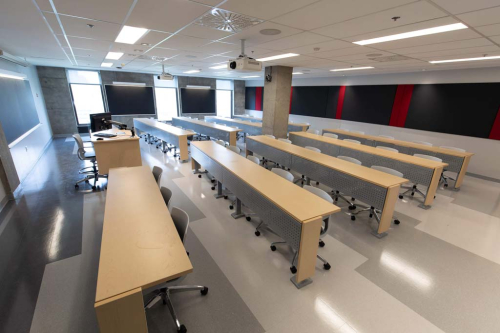- Location: 805 Sherbrooke Street West, Montreal, QC
- Capacity: 50 students
- Type: Flat classroom
Alignment with principles for designing Teaching and Learning Spaces
Academic challenge
Promote individual, active engagement with content.
Layout
Students can work individually or in groups at large rectangular tables, configured in rows, with an ample work surface for classroom materials (e.g., notebooks, laptops, textbooks).
Acoustics: Design includes acoustic panels to mitigates distraction from outside and inside noise sources.
Furniture
Comfortable, adjustable, ergonomically approved chairs with wheels permit rapid transitions between individual and group learning activities.
Technologies
Access to resources: Learning Management System and internet via student laptops. Access to infrastructure: Some electrical plugs for student laptops around the perimeter of the room. Possibilty for two sources (instructor laptop, podium PC) and screens for simultaneous display of different learning materials.
Lighting & colour
Tall windows create a spacious environment with ample natural light. Appropriate overhead and natural lighting supports individual work during or outside of class time.

Learning with peers
Promote active engagement with one another.
Layout
A layout with rectangular tables in rows permits students to collaborate with one another and move easily from small group to larger group activities. Students at each table can work together in smaller groups of two, or turn around and work in groups of four. students are able to move about easily in the classroom due to sufficient passing space between tables. Sight lines are unobstructed.
Acoustics: Sound zones support multiple simultaneous conversations among students.
Furniture
Comfortable, adjustable-height chairs on wheels permit students to turn to discuss and work with those next to or behind them. Armless chairs allow students to easily turn and discuss in pairs or small groups, supporting collaborative learning.
Technologies
Blackboards wrap around three walls of the room, providing ample shared workspace for student brainstorming, work projects, and presenting.
Lighting & colour
Windows and overhead lighting support group work. Tables are identified with unique letters. Tall windows bring in natural light. Different lighting patterns and levels support different learning activities. Grey accent acoustic panels and natural wood tabletops bring a soothing, organic element to this space.

Experiences with faculty
Promote interaction and communication.
Layout
Instructor has access to all students due to a layout with clear sightlines and aisles.
Acoustics: Sounds zones ensure that not only are students able to hear the instructor, but that the instructor is also able to hear the students. Sounds zones support multiple simultaneous conversations.
Furniture
The podium provides ample space for instructional materials and technology, and has a height adjustment for accessibility and convenience. Mobile chairs support different teaching strategies (e.g. group work in various sizes).
Technologies
Multiple projecting surfaces and dual-source projecting permit the display of different learning materials at the same time (e.g. from the instructor's laptop and the podium PC).
Lighting & colour
The lighting patterns provide a bright, pleasant environment and support multiple types of teaching and learning tasks. The acoustic panels provide colour in the form of a constrasting patterns of black and red fabrics.

Contributions to the campus environment
Classrooms that incorporate elements of active and collaborative learning are part of a vision for a variety of flexible campus learning spaces. This classroom is designed for all populations using the space: well-lit, with a standardized room control panel that simplifies instructors’ use of equipment in classrooms across campus. IT is consistent with teaching and learning needs, and durable furniture contributes to sustainability efforts. Both physical and virtual affordances help maximize High Impact Practices (HIPs) for student learning within and beyond this classroom.
